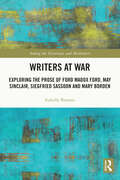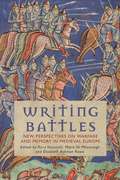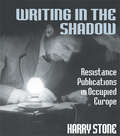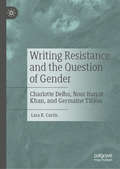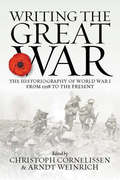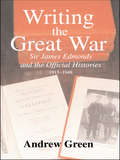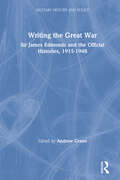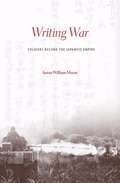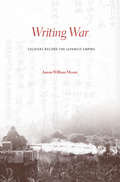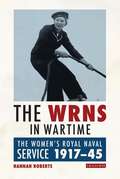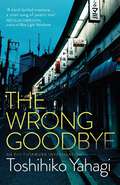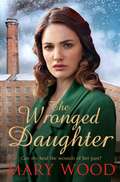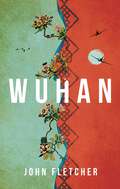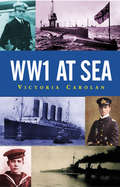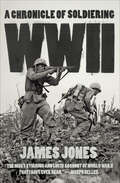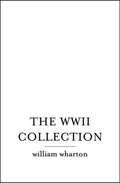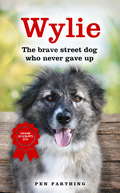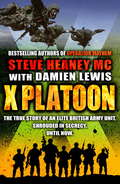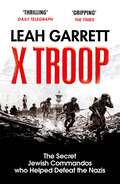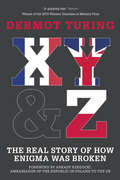- Table View
- List View
Writers at War: Exploring the Prose of Ford Madox Ford, May Sinclair, Siegfried Sassoon and Mary Borden (Among the Victorians and Modernists)
by Isabelle BrasmeWriters at War addresses the most immediate representations of the First World War in the prose of Ford Madox Ford, May Sinclair, Siegfried Sassoon and Mary Borden; it interrogates the various ways in which these writers contended with conveying their war experience from the temporal and spatial proximity of the warzone and investigates the multifarious impact of the war on the (re)development of their aesthetics. It also interrogates to what extent these texts aligned with or challenged existing social, cultural, philosophical, and aesthetic norms. While this book is concerned with literary technique, the rich scholarship on questions of gender, trauma, and cultural studies on WWI literature serves as a foundation. This book does not oppose these perspectives but offers a complementary approach based on close critical reading. The distinctiveness of this study stems from its focus on the question of representation and form and on the specific role of the war in the four authors’ literary careers. This is the first scholarly work concerned exclusively with theorising writing produced from the immediacy of the war. This book is intended for academics, researchers, PhD candidates, postgraduates and anyone interested in war literature.
Writers at War: Exploring the Prose of Ford Madox Ford, May Sinclair, Siegfried Sassoon and Mary Borden (Among the Victorians and Modernists)
by Isabelle BrasmeWriters at War addresses the most immediate representations of the First World War in the prose of Ford Madox Ford, May Sinclair, Siegfried Sassoon and Mary Borden; it interrogates the various ways in which these writers contended with conveying their war experience from the temporal and spatial proximity of the warzone and investigates the multifarious impact of the war on the (re)development of their aesthetics. It also interrogates to what extent these texts aligned with or challenged existing social, cultural, philosophical, and aesthetic norms. While this book is concerned with literary technique, the rich scholarship on questions of gender, trauma, and cultural studies on WWI literature serves as a foundation. This book does not oppose these perspectives but offers a complementary approach based on close critical reading. The distinctiveness of this study stems from its focus on the question of representation and form and on the specific role of the war in the four authors’ literary careers. This is the first scholarly work concerned exclusively with theorising writing produced from the immediacy of the war. This book is intended for academics, researchers, PhD candidates, postgraduates and anyone interested in war literature.
Writing Battles: New Perspectives on Warfare and Memory in Medieval Europe
by Rory Naismith Máire Ní Mhaonaigh Elizabeth Ashman RoweBattles have long featured prominently in historical consciousness, as moments when the balance of power was seen to have tipped, or when aspects of collective identity were shaped. But how have perspectives on warfare changed? How similar are present day ideologies of warfare to those of the medieval period?Looking back over a thousand years of British, Irish and Scandinavian battles, this significant collection of essays examines how different times and cultures have reacted to war, considering the changing roles of religion and technology in the experience and memorialisation of conflict. While fighting and killing have been deplored, glorified and everything in between across the ages, Writing Battles reminds us of the visceral impact left on those who come after.
Writing Battles: New Perspectives on Warfare and Memory in Medieval Europe
Battles have long featured prominently in historical consciousness, as moments when the balance of power was seen to have tipped, or when aspects of collective identity were shaped. But how have perspectives on warfare changed? How similar are present day ideologies of warfare to those of the medieval period?Looking back over a thousand years of British, Irish and Scandinavian battles, this significant collection of essays examines how different times and cultures have reacted to war, considering the changing roles of religion and technology in the experience and memorialisation of conflict. While fighting and killing have been deplored, glorified and everything in between across the ages, Writing Battles reminds us of the visceral impact left on those who come after.
Writing in the Shadow: Resistance Publications in Occupied Europe
by Harry StoneThe first complete national and international survey in the English language of the clandestine newspapers and books published in the occupied countries of Europe during the Second World War.A man with earphones crouching in the attic listening in with a crystal set, a prisoner writing fearfully even in the condemned cell, youths taking courses in weightlifting so as to be able to carry cases of lead type with apparent ease: these are just some of the people who helped produce clandestine newspapers and books in the occupied countries of Europe during the Second World War. Writing in the Shadow describes the risks these people ran and the ingenuity and brilliant improvisation they used to hoodwink the Nazis and distribute newsletters to tens of thousands of people.
Writing in the Shadow: Resistance Publications in Occupied Europe
by Harry StoneThe first complete national and international survey in the English language of the clandestine newspapers and books published in the occupied countries of Europe during the Second World War.A man with earphones crouching in the attic listening in with a crystal set, a prisoner writing fearfully even in the condemned cell, youths taking courses in weightlifting so as to be able to carry cases of lead type with apparent ease: these are just some of the people who helped produce clandestine newspapers and books in the occupied countries of Europe during the Second World War. Writing in the Shadow describes the risks these people ran and the ingenuity and brilliant improvisation they used to hoodwink the Nazis and distribute newsletters to tens of thousands of people.
Writing Resistance and the Question of Gender: Charlotte Delbo, Noor Inayat Khan, and Germaine Tillion
by Lara R. CurtisThis book presents the first comparative study of the works of Charlotte Delbo, Noor Inayat Khan, and Germaine Tillion in relation to their vigorous struggles against Nazi aggression during World War II and the Holocaust. It illuminates ways in which their early lives conditioned both their political engagements during wartime and their extraordinary literary creations empowered by what Lara R. Curtis refers to as modes of ‘writing resistance.’ With skillful recourse to a remarkable variety of genres, they offer compelling autobiographical reflections, vivid chronicles of wartime atrocities, eyewitness accounts of victims, and acute perspectives on the political implications of major events. Their sensitive reflections of gendered subjectivity authenticate the myriad voices and visions they capture. In sum, this book highlights the lives and works of three courageous women who were ceaselessly committed to a noble cause during the Holocaust and World War II.
Writing Resistance in the Second World War: Secrecy and Participation in Newspapers (Neglected Voices from the Past)
by Jane L. ChapmanThis book aims to extend existing historical, literary and media knowledge of neglected written voices as a form of print participation in the Second World War. Uniquely, it is framed by an awareness of contemporary requirements for both secrecy and deception, which, it is argued, were nevertheless characterised by a rare participatory inclusivity in terms of writers and audiences - that has hitherto only been perceived as a characteristic of ‘citizen’s journalism’ in the internet age. Comparative cases of resistance using newspapers during the Second World War comprise original and clandestine sources from France, Belgium, the Netherlands, Norway, and Britain - analysed for the effect that intelligence and planned deception had on local publications as well as on readers of resistance broadsheets.
Writing the Great War: The Historiography of World War I from 1918 to the Present
by Christoph Cornelissen and Arndt WeinrichFrom the Treaty of Versailles to the 2018 centenary and beyond, the history of the First World War has been continually written and rewritten, studied and contested, producing a rich historiography shaped by the social and cultural circumstances of its creation. Writing the Great War provides a groundbreaking survey of this vast body of work, assembling contributions on a variety of national and regional historiographies from some of the most prominent scholars in the field. By analyzing perceptions of the war in contexts ranging from Nazi Germany to India’s struggle for independence, this is an illuminating collective study of the complex interplay of memory and history.
Writing the Great War: The Historiography of World War I from 1918 to the Present
by Christoph Cornelissen Arndt WeinrichFrom the Treaty of Versailles to the 2018 centenary and beyond, the history of the First World War has been continually written and rewritten, studied and contested, producing a rich historiography shaped by the social and cultural circumstances of its creation. Writing the Great War provides a groundbreaking survey of this vast body of work, assembling contributions on a variety of national and regional historiographies from some of the most prominent scholars in the field. By analyzing perceptions of the war in contexts ranging from Nazi Germany to India’s struggle for independence, this is an illuminating collective study of the complex interplay of memory and history.
Writing the Great War: Sir James Edmonds and the Official Histories, 1915-1948
by Andrew GreenBegun within months of the war's outbreak, and not completed for a further 33 years, the writing of the Official Histories of World War I was a venture of unprecedented scale and complexity.Who, then, was responsible for producing such an enterprise? Did it aim to inform or did it have darker political motivations? Did the authors, who alone had ac
Writing the Great War: Sir James Edmonds and the Official Histories, 1915-1948 (Military History And Policy Ser. #No. 11)
by Andrew GreenBegun within months of the war's outbreak, and not completed for a further 33 years, the writing of the Official Histories of World War I was a venture of unprecedented scale and complexity.Who, then, was responsible for producing such an enterprise? Did it aim to inform or did it have darker political motivations? Did the authors, who alone had ac
Writing War: Soldiers Record The Japanese Empire
by Aaron William MooreWriting War examines over two hundred diaries, and many more letters, postcards, and memoirs, written by Chinese, Japanese, and American servicemen in the Pacific from 1937 to 1945. As he describes conflicts that have often been overlooked by historians, Aaron William Moore reflects on diaries as tools in the construction of modern identity.
Writing War: Soldiers Record The Japanese Empire
by Aaron William MooreWriting War examines over two hundred diaries, and many more letters, postcards, and memoirs, written by Chinese, Japanese, and American servicemen in the Pacific from 1937 to 1945. As he describes conflicts that have often been overlooked by historians, Aaron William Moore reflects on diaries as tools in the construction of modern identity.
The WRNS in Wartime: The Women's Royal Naval Service 1917-1945 (International Library of War Studies)
by Hannah RobertsThe Women's Royal Naval Service (WRNS) was created in 1917, re-formed in 1938 and maintained after 1945. This book determines for the first time the reasons for the expansion and contraction of the service and the impact key individuals had on it and in turn the influence it had on its members. Hannah Roberts offers new insights into a previously little studied British military institution, which celebrates its centenary in 2017. She shows how political and military decision-making within the fluctuating national security situation, coupled with a growing cultural acceptability of women taking on military roles, allowed for the growth of the service in World War II into realms never expected of women. Although it shared a similar pattern in its formation to the Auxiliary Territorial Service (ATS) and had a similar ethos to its Air Force counterpart, the WAAF, the WRNS took on a wider-ranging role in the war, in part due to the latitude afforded to the service because of its uniquely independent origins. From 1941 onward the WRNS spread internationally and subverted the combat taboo by adopting semi-combatant roles. Using twenty-one new oral histories and a multitude of archived personal documents, this book demonstrates the pivotal importance of the Women's Royal Naval Service in both the world wars.
The Wrong Goodbye
by Toshihiko YahagiA classic slice of Japanese hard-boiled noir paying homage to the master of the genre: Raymond ChandlerThe Wrong Goodbye pits homicide detective Eiji Futamura against a shady Chinese business empire and U.S. military intelligence in the docklands of recession Japan. After the frozen corpse of immigrant barman Tran Binh Long washes up in midsummer near Yokosuka U.S. Navy Base, Futamura meets a strange customer from Tran's bar. Vietnam vet pilot Billy Lou Bonney talks Futamura into hauling three suitcases of "goods" to Yokota US Air Base late at night and flies off leaving a dead woman behind. Thereby implicated in a murder suspect's escape and relieved from active duty, Futamura takes on hack work for the beautiful concert violinist Aileen Hsu, a "boat people" orphan whose Japanese adoption mother has mysteriously gone missing. And now a phone call from a bestselling yakuza author, a one-time black marketeer in Saigon, hints at inside information on "former Vietcong mole" Tran and his "old sidekick" Billy Lou, both of whom crossed a triad tycoon who is buying up huge tracts of Mekong Delta marshland for a massive development scheme. As the loose strands flashback to Vietnam, the string of official lies and mysterious allegiances build into a dark picture of the U.S.-Japan postwar alliance. Translated from the Japanese by Alfred Birnbaum
The Wronged Daughter: A Heart-Warming Wartime Saga Perfect For Winter Nights (The Girls Who Went To War)
by Mary WoodPerfect for winter nights, The Wronged Daughter by Mary Wood is an emotional and moving novel that reunites old friends and heals old wounds. Mags has never forgotten the friendship she forged with Flora and Ella, two fellow nurses she served with at the beginning of World War I. Haunted by what she experienced during that time, she fears a reunion with her friends would bring back the horror she’s tried so desperately to suppress. Now, with her wedding on the horizon, this should be a joyful time for Mags. But the sudden loss of her mother and the constant doubt she harbours surrounding her fiancé, Harold, are marring her happiness. Mags throws herself into running the family mill, but she’s dealt another aching blow by a betrayal that leaves her reeling. Finding the strength the war had taken from her, she fights back, not realizing the consequences and devastating outcome awaiting her. Can she pick up the pieces of her life and begin anew?
Wuhan
by John FletcherA multi-stranded historical epic set in China in 1937, when Wuhan stood alone against a whirlwind of war and violence.'Fletcher impresses in this searing debut... Fletcher makes all his characters realistic, even if they only appear briefly, and excels at portraying the horrors of war and the moral challenges it poses. Fans of J.G. Ballard's Empire of the Sun will be riveted' Publishers Weekly, Starred Review 1937. CHINA IS AT WAR.Soldiers of the Empire of Japan sweep through the country, killing and displacing the millions who stand in their way. As vast swathes of the country fall to the invaders, Wuhan, an industrial city in the centre of China, is appointed wartime capital. While the rest of the world looks the other way, the citizens of Wuhan stand alone against a whirlwind of violence – transforming militarily, educationally, medically and culturally.Their heroic efforts halted the Japanese.Weaving together a multitude of narratives, Wuhan is a historical fiction epic that pulls no punches: the heart-in-mouth tale of a peasant family forced onto a thousand-mile refugee death-march; the story of Lao She – China's greatest writer – leaving his family in a war zone to assist with the propaganda effort in Wuhan; the hellish battlefields of the Sino-Japanese war; the approaching global conflict seen through a host of colourful characters – from Chiang Kai-Shek, China's nationalist leader, to Peter Fleming, a British journalist based in Wuhan and the prototype for his younger brother Ian Fleming's James Bond.
WW1 at Sea (Pocket Essential Ser.)
by Victoria CarolanImages of WWI in the popular consciousness normally involve the bloody attrition of trench warfare, the miles of mud, the shattered earth, the tangled miles of barbed wire. However there was another significant arena of war - the battle for control of the sea.In 1914 at the beginning of the war, Britain's maritime supremacy had remained unchallenged for around a hundred years. Many expected another Battle of Trafalgar but advances in technology saw a very different kind of warfare with the widespread use of mines, submarines and torpedoes.This book examines the events that led to war and the naval arms race between Britain and Germany. It traces the events of the war at sea looking at the major battles as well as the effects of unrestricted submarine warfare and the sinking of the Lusitania. It also profiles key figures such as Fisher, Beatty, Tirpitz and Graf von Spee.'This A5-sized hardback book traces the naval arms race between Britain and Germany prior to World War 1' - Ships Monthly
WWII: A Chronicle of Soldiering
by James JonesIn 1975, James Jones—the American author whose novels From Here to Eternity and The Thin Red Line had made him the preeminent voice of the enlisted man in World War II—was chosen to write the text for an oversized coffee table book edited by former Yank magazine art director Art Weithas and featuring visual art from World War II. The book was a best seller, praised for both its images and for Jones’s text, but in subsequent decades the artwork made it impossible for the book to be reproduced in its original form, and it fell out of print and was forgotten. This edition of WWII makes available for the first time in more than twenty years Jones’s stunning text, his only extended nonfiction writing on the war that defined his generation. Moving chronologically and thematically through the complex history of the conflict, Jones interweaves his own vivid memories of soldiering in the Pacific—from the look on a Japanese fighter pilot’s face as he bombed Pearl Harbor, so close that Jones could see him smile and wave, to hitting the beach under fire in Guadalcanal—while always returning to resounding larger themes. Much of WWII can be read as a tribute to the commitment of American soldiers, but Jones also pulls no punches, bluntly chronicling resentment at the privilege of the officers, questionable strategic choices, wartime suffering, disorganization, the needless loss of life, and the brutal realization that a single soldier is ultimately nothing but a replaceable cog in a heartless machine. As the generation that fought and won World War II leaves the stage, James Jones’s book reminds us of what they accomplished—and what they sacrificed to do so.
The WWII Collection
by William WhartonFrom one of America’s best loved authors comes this collection of WWII novels.
Wylie: The Brave Street Dog Who Never Gave Up
by Pen Farthing'When people gave up on Wylie, Wylie refused to give up on people.'For a street dog born in the city of Kandahar, Afghanistan, to be crowned top dog at Scruffts, a competition for crossbreeds held during Crufts, the largest dog show on earth, is nothing short of a miracle. But for Wylie, the gentle, cropped eared ball of fur, miracles seemed to happen quite regularly. Beaten and abused while being used as a bait dog, Wylie suffered terrible injuries that needed urgent treatment. Rescued close to death, with hacked off ears and a severed tail, he was attended to by soldiers who feared he would not last the night. Astonishingly he did, only to return days later with new injuries. However a lifeline came when he was handed over to animal welfare Charity Nowzad and flown to Britain in the hope of finding a new life. But would anyone take a chance on a seemingly nervous and undomesticated stray? Luckily for Wylie his biggest adventure yet was about to begin...This is the incredible and heart-warming story, full of tragedy and triumph, of a dog who never gave up hope.
X Platoon
by Damien Lewis Steve Heaney, MCFor three decades one of the most secretive units in the British military has been a mystery force known as X Platoon.Officially there was no X Platoon. The forty men in its elite number were specially selected from across the Armed Forces, at which point they simply ceased to exist. X Platoon had no budget, no weaponry, no vehicles and no kit - apart from what its men could beg, borrow or steal from other military units.For the first time a highly decorated veteran of this specialised force - otherwise known as the Pathfinders - reveals its unique story. Steve Heaney became one of the youngest ever to pass Selection, the gruelling trial of elite forces, and was at the cutting edge of X Platoon operations - serving on anti-narcotics operations in the Central American jungles, on missions hunting war criminals in the Balkans, and being sent to spy on and wage war against the Russians.The first non-officer in the unit's history to be award the Military Cross, Steve Heaney reveals the extraordinary work undertaken by this secret band of brothers.
X Troop: The Secret Jewish Commandos Who Helped Defeat the Nazis
by Leah Garrett'This is Inglorious Basterds - but much better. Because it is the real story of clandestine Jewish fighters wreaking havoc against the Nazi war machine' Norman Ohler, author of BlitzedJune 1942. The shadow of the Third Reich has fallen across the entire European continent. In desperation, Winston Churchill and his chief of staff form an unusual plan: a new commando unit made up of Jewish refugees from Germany and Austria who escaped to Britain just before the War. Many have lost their families, their homes - their whole worlds. And now, in the crucial final battles against the Nazis, they will stop at nothing to defeat them. Trained in counterintelligence and advanced combat, this top secret unit becomes known as X Troop. Some simply call them a suicide squad.Drawing on extensive original research, including interviews with the last surviving members, Leah Garrett follows this unique band of brothers from Europe to England and back again, with stops at British internment camps, the beaches of Normandy, the battlefields of Italy and Holland, and the hellscape of Terezin concentration camp - the scene of one of the most dramatic, untold rescues of the war. For the first time, X Troop tells the astonishing story of these secret shock troops and their devastating blows against the Nazis.
X, Y & Z: The Real Story of How Enigma Was Broken
by Dermot TuringX, Y & Z describes how French, British and Polish secret services came together to unravel the Enigma machine. It tells of how, under the very noses of the Germans, Enigma code-breaking continued in Vichy France. And how code-breakers from Poland continued their work for Her Majesty’s Secret Service, watching the USSR’s first steps of the Cold War. The people of X, Y and Z were eccentric, colourful and caught up in world events that they could watch not control. This is their story…
